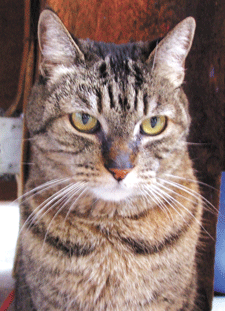
APRIL 27, 2011
Are you causing your pet to be stressed?
How stress and diet can affect dogs and cats
 You might not realize it, but if Fluffy or Skippy are listless, disobedient and getting sick all the time, chances are that your pet doesn’t have some mysterious disease – he or she may simply be stressed out.
You might not realize it, but if Fluffy or Skippy are listless, disobedient and getting sick all the time, chances are that your pet doesn’t have some mysterious disease – he or she may simply be stressed out.
“A lot of people think that stress is something that only affects humans, but it’s a very real threat to the health and happiness of their pets, too,” said Dr. Paul McCutcheon, a veterinarian with more than 45 years experience and co-author of The New Holistic Way for Dogs and Cats from Random House (www.newholisticway.com). “Better pet care will result when pet lovers and veterinarians understand that stress is the underlying cause of every form of health problem a dog or cat can have.”
Dr. McCutcheon believes that stress, combined with diet and other environmental concerns, can present serious – but unspecific – symptoms that can worry both pet and pet owner.
“It is important to distinguish between acute stress, immediate and intense, versus chronic stress, a real drag on wellness that results from a long-standing cause of stress,” he said. “The best way to support your pet’s present and future wellness is through stress prevention. Tune into the kinds of stress that affect your pet and stress-proof the ways you look after their daily needs. For instance, boredom and loneliness are probably the most damaging stress factors in a pet’s life.”
Dr. McCutcheon’s tips for pet owners who want healthier, happier pets include:
Think before you adopt – It’s critical to ask yourself serious questions about your lifestyle and future before you adopt a pet. In that sense, you can better choose an animal whose needs are similar to your own. By being honest with yourself about your personal circumstance, you can ensure that your pet won’t face a stressful future and inevitable health problems.
Establish your role – You need to see your veterinarian’s role in a different way. While you are in the best position to influence your dog or cat, your veterinarian can be a good coach who provides you opinions and advice that help you make better choices regarding the care and feeding of your pet.
Watch their diet – Just as processed foods are being blamed for an increase in obesity for people, causing a wide variety of health problems, processed food is a danger for pets, as well. Look into switching over to a new trend in pet food, raw foods. They can be found in pet specialty shops and grocery stores in the refrigerated section. They are also known as “fresh” foods for pets, so ask your store managers about them. They provide a balanced diet with none of the dangers associated with processed food, which makes up the majority of the pet foods available at pet stores and supermarkets today.
“There is a new holistic way of caring for your pet that incorporates a combination of many different approaches to health care – traditional, indigenous, energy-based, and recent developments in Western science all contribute to this new method. There is a direct relationship between the emotional health of a pet and that pet’s physical health, just as there is in humans. When we’re stressed out from work or family issues, our immune systems suffer. We lose sleep, and we are far more susceptible to the bug that’s always going around. We’re mammals, and so are dogs and cats. What makes us think they are any different? The truth is, when we’re stressed out, so are our pets. Just as pets can sense anger, fear or illness in us – which explains why pets try to comfort us when we’re sick – they can also sense our stress. By addressing the stress in our own lives, we can help keep our pets stress-free and prevent many of the common illnesses that plague them, making them happy and healthy companions for a long time to come.”
Paul McCutcheon, DVM, is the founder of Toronto’s East York Animal Clinic and has hosted the popular Canadian television series Perfect Pet People and the radio show People and Pets.
APRIL 27, 2011
Urban wildlife is more active this time of year
Human-wildlife conflicts can occur
PHOENIX – You may be more likely to see a coyote or bobcat in your neighborhood these days, but that is not unusual for this time of year, say biologists with the Arizona Game and Fish Department.
Warming spring temperatures and the tail end of the breeding season for many wildlife species make them more active and likely to be seen.
“If you see an animal such as a coyote, bobcat or javelina near your home, there’s no need to panic, but it’s a good idea to keep your distance and be observant of the animal’s behavior,” says Darren Julian, urban wildlife specialist with Game and Fish.
Wildlife aggression and attacks on humans aren’t common, but they can happen.
A two-year-old girl was nipped by a coyote in Cave Creek Park in Phoenix last Friday evening as she was sitting in a sandy area of the playground with several other children. The parents and other nearby adults chased the coyote away. The girl was not seriously hurt, but she did undergo precautionary shots for potential rabies exposure.
Game and Fish removed six coyotes from the nearby area and submitted them for rabies testing. Test results are pending.
“When wild animals come into neighborhoods, they are usually looking for food, water or shelter,” says Julian. “If you make it hard for the animals to find these things, they are less likely to hang around your house or neighborhood.”
Coyotes in particular are very resilient and adaptable, and they can become used to being around areas of human activity, particularly neighborhoods near urban-wildland interfaces, or even parks and golf courses.
“Keep in mind these are wild animals, and their behavior can be unpredictable,” says Julian. “They typically don’t show aggression toward humans, but if you feed them or make them feel welcome in your area, that can raise the chance of a human-wildlife conflict.”
Here are some things you can do to lessen the chance of a wildlife encounter on your property:
Do not feed wildlife under any circumstances. (In Maricopa and Pima counties, it is against the law to feed wildlife other than birds and tree squirrels)
Remove wildlife attractants, such as dog food and water bowls, from around your home.
Make possible den sites or shelters unavailable by blocking them with fencing or other devices.
Keep small household pets indoors.
Let the animal know it’s not welcome by making it uncomfortable. You can do this by shouting at the animal, banging pots and pans together, spraying it with a hose from a distance, or by illuminating the area at night.
Rabies is another reason wildlife may show aggression toward humans. The disease is rarely seen in Maricopa County, but can occur in any mammal. Signs of rabies include staggering, foaming at the mouth, and lethargic or hyperactive behavior.
If a wild animal will not leave your property after you repeatedly try to frighten it away, or if it is showing signs of aggressive or unusual behavior, call the Arizona Game and Fish Department at 602-942-3000.
For more information on living with urban wildlife, visit the Game and Fish Department website at www.azgfd.gov/urbanwildlife.



